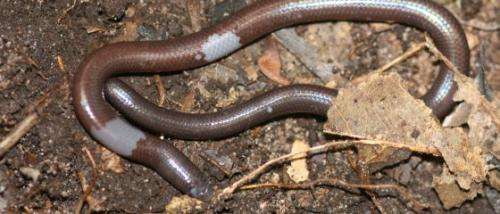Cambodian scientist discovers new species of blind and legless lizard

First on record in Cambodia and the first reptile to be both discovered and formally described in a scientific journal by a Cambodian national.
Cambodian national Neang Thy thought he had found a common flowerpot snake when he turned over a log in the Cardamom Mountains and noticed a small worm-like creature trying to flee from the sudden light. On closer inspection the diminutive reptile was revealed to be a peculiar type of lizard that is both blind and legless.
“At first I thought it was a common species”, said Thy, who works as a herpetologist with the Ministry of Environment and Fauna & Flora International (FFI), “but looking closer I realised it was something I didn’t recognise.”
These cryptic species of reptile are easily overlooked and previous to this discovery there are no records for blind lizards occurring in Cambodia. The species was finally named the Dalai Mountain blind lizard Dibamus dalaiensis, after the mountain on which it was found.
Recent biological surveys in Cambodia have resulted in a wealth of unusual new species, ranging from carnivorous plants to a green-bloodied frog. “This latest find is particularly remarkable,” said Dr Jenny Daltry, Senior Conservation Biologist with FFI, “because it is not only a new species, but also the first reptile to be both discovered and formally described in a scientific journal by a Cambodian national”.
The process of describing and naming a new species is a complex one, and Thy learned this discipline during a study period in La Sierra University in the United States.
“For one of our national colleagues to discover this unusual species and make the description is particularly satisfying,” said Berry Mulligan, FFI’s Cambodia operations manager. “It shows that the capacity of Cambodian scientists is now reaching an international standard.”
The species: Dibamus dalaiensis. The genus Dibamus composes 21 species found throughout Southeast Asia. Known from Thailand and Vietnam, the genus had not been seen in Cambodia before this discovery, but was expected to occur. These small lizards are blind and without limbs (small, flap-like hind limbs occur in the males) and spend most of their lives underground.
Provided by Fauna & Flora International


















